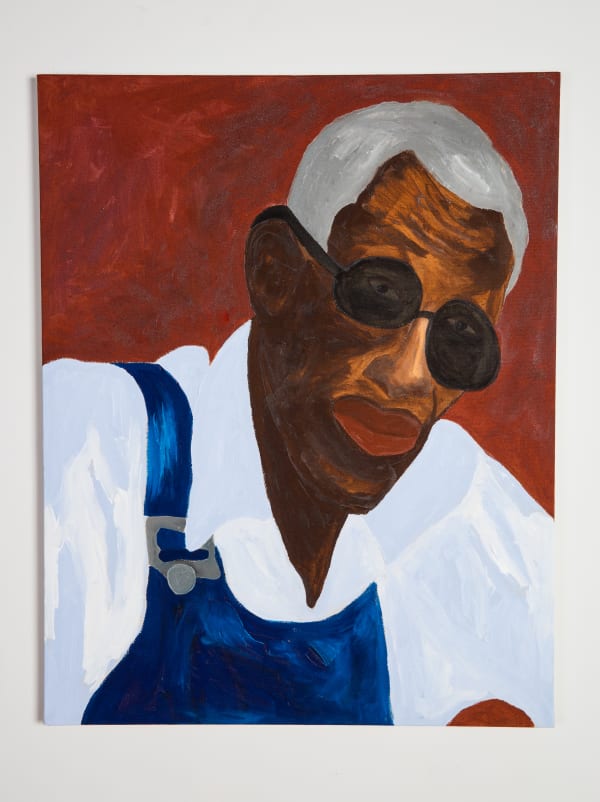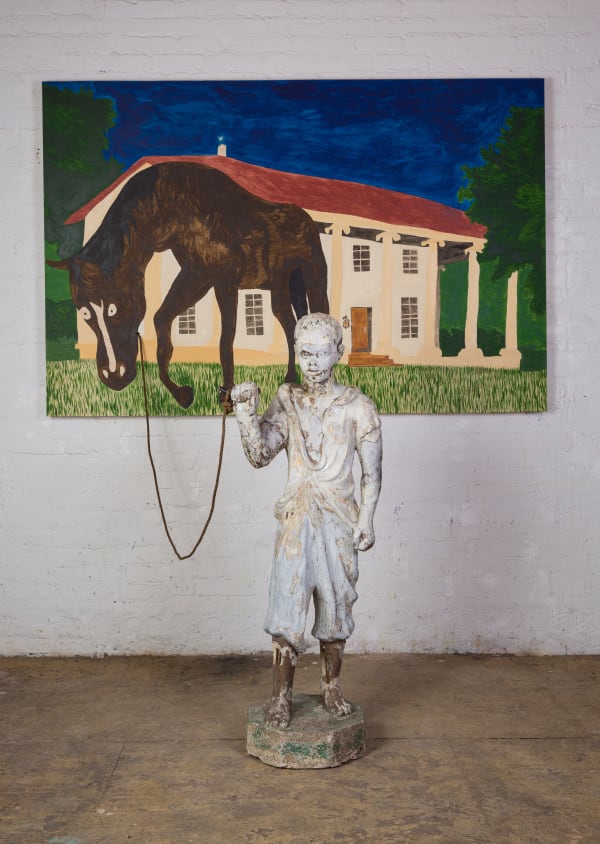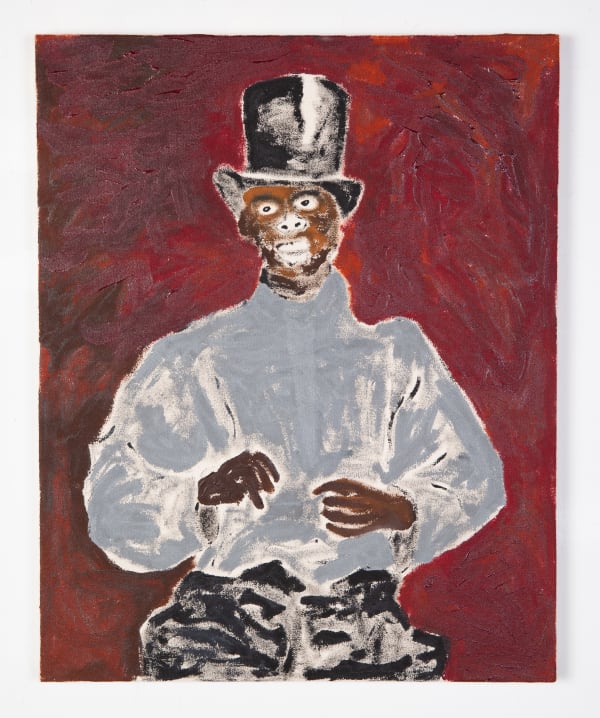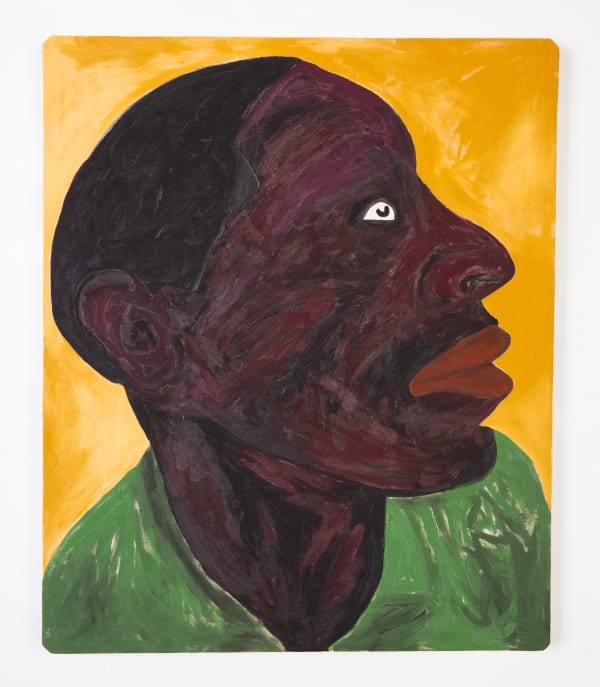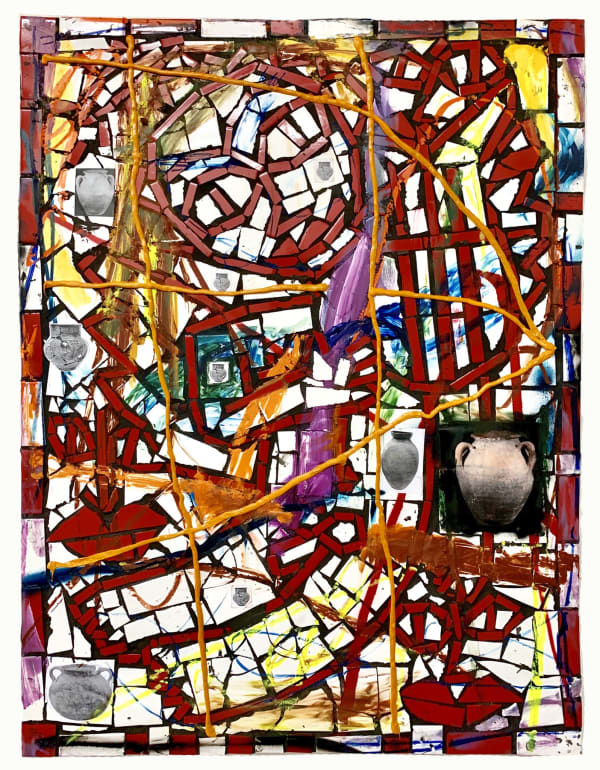Then & Now: Chase Hall and Cameron Welch
Jenkins Johnson Projects, New York is pleased to present Then & Now, an exhibition curated by Antwaun Sargent, featuring new works by Chase Hall and Cameron Welch. The title draws upon the artists’ investigations of history and its resonance with contemporary life. Selected works are placed in dialogue, sharing formal explorations of the medium of painting. Whether it is through Welch’s use of collage elements in wall-mounted mosaic reliquaries (that he considers paintings) or through Hall’s inventive use of the white space to help achieve his portraits, both artists rethink the contemporary possibilities of the medium. Their unique painting styles and techniques also allow Hall and Welch to conceptually interrogate histories of painting that have reinforced dominant narratives which often erased or overlooked Black contributions to modern and contemporary art. Both artists are based out of New York, continuing the Project Space’s commitment to dialogue and engagement with the local community.
Opening Reception:
Saturday, September 7, 2019, 5 - 8 pm
Curated by Antwaun Sargent
Jenkins Johnson Projects, New York is pleased to present Then & Now, an exhibition curated by Antwaun Sargent, featuring new works by Chase Hall and Cameron Welch. The title draws upon the artists’ investigations of history and its resonance with contemporary life. Selected works are placed in dialogue, sharing formal explorations of the medium of painting. Whether it is through Welch’s use of collage elements in wall-mounted mosaic reliquaries (that he considers paintings) or through Hall’s inventive use of the white space to help achieve his portraits, both artists rethink the contemporary possibilities of the medium. Their unique painting styles and techniques also allow Hall and Welch to conceptually interrogate histories of painting that have reinforced dominant narratives which often erased or overlooked Black contributions to modern and contemporary art. Both artists are based out of New York, continuing the Project Space’s commitment to dialogue and engagement with the local community.
This exhibition examines the ways in which these artists use painting and ready-made sculpture and traditions of craft to deconstruct fixed notions of race and memory. The artists in this exhibition consider both societal and personal history to protest master narratives of American history, codified through language and action. Their paintings and sculptures draw on popular national myths, figures and understandings of identity to propose new possibilities of being that seek to disempower mainstream narratives that inform common understandings of art, history and race. On their canvases, that oscillate between history painting and mythology, untold and new stories of the Black American experience unfold.
Chase Hall’s work across painting and sculpture activates and disrupts generational traumas encoded in American historical memorabilia. The self-taught artist’s practice is rooted in researching the visual systems in which racism lives and how these images and objects have played a role in the popular constructions of blackness. Hall is drawn to how these objects, such as lawn ornaments, dish towels and rag dolls have signified or perpetuated segregation, the dehumanization of blackness, and a one-sided version of American history told by people and institutions of power. These objects are imbued with a perverse nostalgia that has been transmitted from one generation to the next. Conversely, Hall’s paintings focus on the resilient fortitude of people who have endured under racist structures and convey this spirit through loose and audacious strokes. His palette permits a color sensibility focusing on the histories of landscape and labor. He uses raw cotton canvas which aim to liberate the paintings from a legacy of American portraiture defined by structures of power and exclusion. Hall’s practice creates a visual language of strength and empathy in hope of a visual and racial literacy to better understand the painful inheritances of the past and its resonance in the present day.
Cameron Welch is interested in establishing gestalt through a myriad of materials, processes, and images. The surface of each work is crafted out of mosaic tile. Each tile piece is cut from a larger block to form every individual line and form throughout the work. This process speaks to both a specific art historical referent as well as an inherent kitsch. Found objects are imbedded in each work to activate the figures portrayed. These labored surfaces are then collaged and painted atop of in a frenetic manner that pushes against the precious nature of the mosaic process. Welch states “I've been thinking a lot about how to speak to the passing of time in an archaeological sense; the petrification of various histories. The objects used in the paintings are frozen like fossils, and the ancient process of tile work speaks to that. The gestures and tools used to eventually 'paint' these panels attempt to capture a certain feverishness, much like a tiled subway wall that's been scrawled on. Each material process and reference employed within this body of work is attempting to create a relic greater than the sum of its parts; an investigation in visual language.”
About Antwaun Sargent
Antwaun Sargent is a writer and critic primarily concerned with the artistic production of black artists. His writing has appeared in the New York Times, The New Yorker, The New Review of Books and various other magazines and newspapers. He has also contributed to museum publications and catalogues for a number of artists including Mickalene Thomas, Arthur Jafa, Ed Clark and Deborah Roberts, among others. He has organized exhibitions at Aperture Foundation, Concordia College and Jenkin Johnson Projects, and has lectured and been in conversation at the Studio Museum in Harlem, Yale University, Harvard University’s Graduate School of Design, the Art Gallery of Ontario, The Brooklyn Museum, Museum of the African Diaspora, San Francisco, among others. This fall Aperture will publish his book titled, The New Black Vanguard: Photography Between Art and Fashion.
-
 Chase Hall, Chef, 2018
Chase Hall, Chef, 2018 -
 Chase Hall, Days Like This, 2019
Chase Hall, Days Like This, 2019 -
 Chase Hall, Her in Front of the Flag, 2019
Chase Hall, Her in Front of the Flag, 2019 -
 Chase Hall, I've Been to the Mountaintop, 2018
Chase Hall, I've Been to the Mountaintop, 2018 -
 Chase Hall, James J.R. Thomas, 2018
Chase Hall, James J.R. Thomas, 2018 -
 Chase Hall, Jarvis, 2018
Chase Hall, Jarvis, 2018 -
 Chase Hall, Jocko Graves (The Faithful Groomsmen), 2018
Chase Hall, Jocko Graves (The Faithful Groomsmen), 2018 -
 Chase Hall, Jocko Where Grandpa Would Sit, 2018
Chase Hall, Jocko Where Grandpa Would Sit, 2018 -
 Chase Hall, Most Likely (To Be Shot at School), 2018
Chase Hall, Most Likely (To Be Shot at School), 2018 -
 Chase Hall, Old Man and the Tree, 2019
Chase Hall, Old Man and the Tree, 2019 -
 Chase Hall, Outside Reginald, 2019
Chase Hall, Outside Reginald, 2019 -
 Chase Hall, Raisin in the Sun, 2019
Chase Hall, Raisin in the Sun, 2019 -
 Chase Hall, Untitled (Fisherman Boy), 2019
Chase Hall, Untitled (Fisherman Boy), 2019 -
 Chase Hall, Fishing with Dad, 2018
Chase Hall, Fishing with Dad, 2018 -
 Cameron Welch, Valentine, 2019
Cameron Welch, Valentine, 2019


